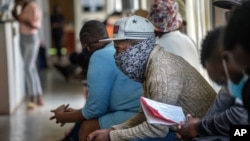Governments and officials around the world are hoping COVID-19 vaccines can create “herd immunity” to protect large populations.
Some experts predict that giving a vaccine to just two-thirds of a population could protect whole communities or nations. But the effectiveness of such efforts is highly dependent on what the vaccines will be able to prevent.
What is herd immunity?
Herd immunity happens when a large percentage “of a community (the herd) becomes immune to a disease, making the spread of disease from person to person unlikely. As a result, the whole community becomes protected — not just those who are immune,” the Mayo Clinic notes on its website.
But there are still many open questions about herd immunity and COVID-19 vaccines.
For example, will the first vaccines be able to stop the spread of the virus, or just stop people from getting sick? How many people in a population will accept a vaccine? Will vaccines offer the same protection to everyone?
Josep Jansa is an expert at the Stockholm-based European Centre for Disease Prevention and Control (ECDC).
“Herd immunity is sometimes wrongly understood as individual protection,” Jansa told the Reuters news agency. He added, “Herd immunity refers to community protection, not to how an individual is protected.”
R Value and disease spread
One of the central questions about herd immunity and COVID-19 is the reproduction rate, or R value, of the virus that causes it. R value is a measure of how many people get the virus from an average infected individual in environments where no restrictions are in place. For example, an R value of 2 means an infected person would be expected to pass the virus on to 2 other people.
Winfried Pickl is a professor at the Medical University of Vienna.
“The problem is that for now we don’t know exactly how fast the virus spreads without any precautions and with the normal travel and social activities we had a year ago,” Pickl told Reuters.
Health experts have noted that anything less than 100 percent vaccine efficacy would require an increase in vaccinations to reach herd immunity. Early data on the leading COVID-19 vaccines – from Pfizer-BioNTech and Moderna - suggests only about 90 percent efficacy.
Amesh Adalja is with the Johns Hopkins Center for Health Security. He said a good target for immunity in the United States would be to have more than 70 percent of the population vaccinated. But the number could go up if vaccines are less effective, he added.
The ECDC uses an estimated herd immunity level of 67 percent for its models. In Germany, Chancellor Angela Merkel said this month that COVID-19 restrictions there could be lifted once 60 to 70 percent of the population reached immunity.
World Health Organization experts have also suggested a 65 to 70 percent vaccine coverage rate as a way to reach population immunity through vaccination.
Vaccines and virus transmission
Experts say another important question is whether vaccines can stop the spread of the coronavirus, which causes the disease COVID-19.
Evidence so far suggests the first COVID-19 vaccines will at least stop people from developing the disease. But it cannot be ruled out that people will still catch the virus and pass it on to others.
Bodo Plachter is a professor and deputy director of the Institute of Virology at Germany’s Mainz University teaching hospital. Plachter said that respiratory infections can be hard to block completely with vaccines - although the shots are expected to reduce the amount of virus that is moving around.
“It may well be that vaccinated people will shed fewer viruses,” he said. “But it would be a mistake,” he added, to think that “vaccination alone can suppress a pandemic.”
I’m John Russell.
Kate Kelland and Ludwig Burger reported on this story for Reuters. John Russell adapted it for Learning English. Bryan Lynn was the editor.
________________________________________________________________
Words in This Story
immune – adj. having special protection from something; of or relating to the body's immune system
refer – v. to talk or write about someone or something
precaution – n. something that is done to prevent possible harm or trouble from happening in the future
efficacy – n. the power to produce a desired result or effect
respiratory – adj. medical: of or relating to breathing or the organs of the body that are used in breathing
shed – v. to get rid of (something); to lose (leaves, skin, fur, etc.) naturally
suppress – v. to slow or stop the growth, development, or normal functioning of (something)









